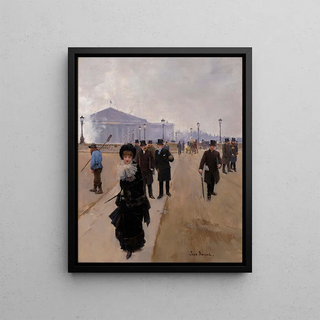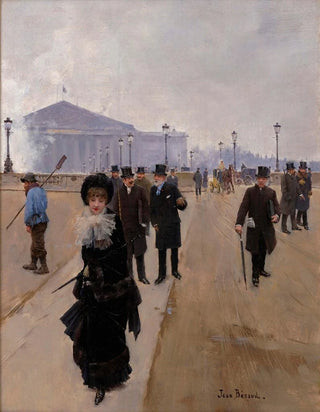Art print | Scene of Concorde Square - Jean Béraud


View from behind

Frame (optional)
Reproduction Scene of Place de la Concorde - Jean Béraud – Captivating Introduction
The "Scene of Place de la Concorde" by Jean Béraud is a work that transports the viewer to the heart of Paris in the 19th century. In this canvas, the artist captures the vibrancy of one of the most iconic squares of the French capital, where daily life and historical events intertwine. Light plays a crucial role in this composition, illuminating the faces and silhouettes of passersby while creating a lively atmosphere. The work is much more than a simple depiction of a place; it is an invitation to explore the soul of Paris at a time when the city was undergoing profound change. Through this art print, Béraud's art continues to evoke emotions, memories, and nostalgia for a bygone era.
Style and uniqueness of the work
Jean Béraud's style is characterized by meticulous attention to detail and a talent for capturing the essence of urban life. In "Scene of Place de la Concorde," each character is carefully rendered, from elegant ladies in crinolines to men in tall hats. The composition is dynamic, with leading lines guiding the eye through the lively scene. The colors, both vivid and delicate, evoke natural light bathing the square, making the atmosphere both festive and melancholic. Béraud's technique, blending realism and impressionism, allows viewers to feel the movement and energy of the crowd, making this work a true tableau of Parisian life at its peak.
The artist and his influence
Jean Béraud, born in 1849, is often regarded as one of the most representative painters of the Belle Époque. His work stands out for its ability to immortalize moments of daily life with a unique sensitivity. Influenced by the great masters of the past, he skillfully integrated modern elements into his art, capturing the evolution of French society. Béraud also played a key role in depicting Parisian life, reflecting the social and cultural changes of his time. His work has inspired many artists and continues to influence the way we perceive

Matte finish

View from behind

Frame (optional)
Reproduction Scene of Place de la Concorde - Jean Béraud – Captivating Introduction
The "Scene of Place de la Concorde" by Jean Béraud is a work that transports the viewer to the heart of Paris in the 19th century. In this canvas, the artist captures the vibrancy of one of the most iconic squares of the French capital, where daily life and historical events intertwine. Light plays a crucial role in this composition, illuminating the faces and silhouettes of passersby while creating a lively atmosphere. The work is much more than a simple depiction of a place; it is an invitation to explore the soul of Paris at a time when the city was undergoing profound change. Through this art print, Béraud's art continues to evoke emotions, memories, and nostalgia for a bygone era.
Style and uniqueness of the work
Jean Béraud's style is characterized by meticulous attention to detail and a talent for capturing the essence of urban life. In "Scene of Place de la Concorde," each character is carefully rendered, from elegant ladies in crinolines to men in tall hats. The composition is dynamic, with leading lines guiding the eye through the lively scene. The colors, both vivid and delicate, evoke natural light bathing the square, making the atmosphere both festive and melancholic. Béraud's technique, blending realism and impressionism, allows viewers to feel the movement and energy of the crowd, making this work a true tableau of Parisian life at its peak.
The artist and his influence
Jean Béraud, born in 1849, is often regarded as one of the most representative painters of the Belle Époque. His work stands out for its ability to immortalize moments of daily life with a unique sensitivity. Influenced by the great masters of the past, he skillfully integrated modern elements into his art, capturing the evolution of French society. Béraud also played a key role in depicting Parisian life, reflecting the social and cultural changes of his time. His work has inspired many artists and continues to influence the way we perceive






